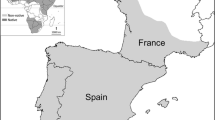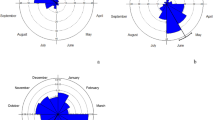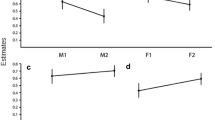Abstract
We describe the reproductive parameters of tufted capuchins (Cebus apella nigritus) in the Iguazú National Park, NE Argentina. We obtained data on six different groups (33 individually recognized adult females) studied for periods of 2–9 years. Estimated birthrate is 0.59 infants per female per year in unprovisioned groups. A group that was provisioned for 6 years during the winter period of low fruit availability (May–August), showed a similar birth rate of 0.61, but a lower infant mortality rate than unprovisioned groups. The birthrate estimated for this population is higher than the one reported for white-faced and wedge-capped capuchins. The mean interbirth interval is 19.35 months, but a female can have infants in successive years, even when her previous infant has survived. The modal age at first delivery is 7 years, which is similar to the one observed in wedge-capped capuchins. When young adult females come into estrous they avoid copulating with the alpha male that sired them, thus providing evidence for a behavioral mechanism of inbreeding avoidance. Births are very seasonal at Iguazú, occurring during the spring and summer months (October–February) when food availability is at its peak. Tufted capuchins at Iguazú are more seasonal breeders than other capuchin populations, probably as a result of their more seasonal environment. The secondary sex ratio does not deviate significantly from 1:1, despite the known ability of capuchins to adjust secondary sex ratio to local conditions.
Similar content being viewed by others
REFERENCES
Batschelet, E. (1981). Circular Statistics in Biology. New York, Academic Press.
Brown, A. D., and Colillas, O. J. (1984). Ecología de Cebus apella. In: A Primatologia no Brasil, An. 1º Congr. Bras. Pprimatologia, Belo Horizonte, 1983. pp. 301–312.
Brown, A. D., and Zunino, G. E. (1990). Dietary variability in Cebus apella in extreme habitats: evidence for adaptability. Folia Primatol. 54: 187–195.
Bulmer, M. (1994). Theoretical Evolutionary Ecology. Sunderland, Massachusetts, Sinauer Associates.
Clark, A. B. (1978). Sex ratio and social resource competition in a prosimian primate. Science 201: 163–165.
Clutton-Brock, T. H., Albon, S. D., and Guinness, F. E. (1984). Maternal dominance, breeding success and birth sex ratios in red deer. Nature 308: 358–360.
Crespo, J. A. (1982). Ecología de la comunidad de mamíferos del Parque Nacional Iguaz ú , Misiones. Revista del Museo Argentino de Ciencias Naturales, Ecología III(2): 1–172.
Di Bitetti, M. S. (1997). Evidence for an important social role of allogrooming in a platyrrhine primate. Anim. Behav. 54: 199–211.
Di Bitetti, M. S. (in press). Home range use by the tufted capuchin monkey, Cebus apella nigritus, in a subtropical rainforest of Argentina. J Zool, London.
Di Bitetti, M. S., and Janson, C. H. (2000). When will the stork arrive? Patterns of birth seasonality in Neotropical Primates. Am. J. Primatol. 50: 109–130.
Dunbar. R. I. M. (1988). Primate Social Systems. Ithaca, New York, Comstock Publishing Associates.
Escobar-Páramo, P. (1999). Inbreeding avoidance and the evolution of male mating strategies. Unpublished Ph. D. Dissertation. State University of New York at Stony Brook.
Fedigan, L. M., and Rose, L. M. (1995). Interbirth interval variation in three sympatric species of Neotropical monkey. Am. J. Primatol. 37: 9–24.
Fedigan, L. M., Rose, L. M., and Morera Avila, D. (1996). See how they grow: tracking capuchin monkey (Cebus capucinus) populations in a regenerating Costa Rican dry forest, pp. 289–307 in Adaptive Radiations of Neotropical Primates. M. A. Norconk; A. L. Rosenberger; P. A. Garber, eds. New York, Plenum Press.
Fragaszy, D. M., and Adams-Curtis, L. E. (1998). Growth and reproduction in captive tufted capuchins (Cebus apella). Am. J. Primatol. 44: 197–203.
Freese, C. H., and Oppenheimer, J. R. (1981). The capuchin monkeys, genus Cebus, pp. 331–390 in Ecology and Behavior of Neotropical Primates vol 1. A. F. Coimbra-Filho and R. A. Mittermeier eds. Rio de Janeiro, Academia Brasileira de Ciencias.
Izawa, K. (1990). Social changes within a group of wild black-capped capuchins (Cebus apella) in Colombia (II). Field Studies of New World Monkeys, La Macarena, Colombia 3: 1–5.
Izawa, K. (1992). Social changes within a group of wild black-capped capuchins (Cebus apella) in Colombia (III). Field Studies of New World Monkeys, La Macarena, Colombia 7: 9–14.
Janson, C. H. (1984). Female choice and mating system of the brown capuchin monkey, Cebus apella (Primates: Cebidae). Z. Tierpsychol. 65: 177–200.
Janson, C. H. (1985). Aggressive competition and individual food consumption in wild brown capuchin monkeys (Cebus apella). Behav. Ecol. Sociobiol. 18: 125–138.
Janson, C. H. (1996). Toward an experimental socioecology of primates: examples from Argentine brown capuchin monkeys (Cebus apella nigritus). In: Adaptive Radiations of Neotropical Primates (Ed. by M. Norconk, P. Garber and A. Rosenberger). New York: Plenum Press.
Janson, C. H., and Di Bitetti, M. S. (1997). Experimental analysis of food detection in capuchin monkeys: effects of distance, travel speed and resource size. Behav. Ecol. Sociobiol. 41: 17–24.
Lack, D. (1947). The significance of clutch size. Ibis 89: 302–352.
Lack, D. (1954). The natural regulation of animal numbers. Oxford, Oxford University Press.
McFarland Symington, M. (1987). Sex ratio and maternal rank in wild spider monkeys: when daughters disperse. Behav. Ecol. Sociobiol. 20: 421–425.
Mitchell,B. J. (1989). Resources, group behavior, and infant development in white-faced capuchin monkeys, Cebus capucinus. Unpublished Ph. D. Dissertation. University of California at Berkeley.
Nagle and Denari (1983). The Cebus monkey (Cebus apella), pp. 39–67 in Reproduction in New World Primates: New Models in Medical Science. J Hearn ed. MTP Press Limited.
National Research Council (1981). Techniques for the Study of Primate Population Ecology. National Academy Press, Washington D. C.
Placci, L. G., Arditi, S. I., and Ciotek, L. E. (1994). Productividad de hojas, flores y frutos en el Parque Nacional Iguazú . Yvirareta 5: 49–56.
Robinson, J. G. (1988). Demography and group structure in wedge-capped capuchin monkeys, Cebus olivaceus. Behaviour 104: 202–232.
Robinson, J. G., and Janson, C. H. (1987). Capuchins, squirrel monkeys, and atelines: Socioecological convergence with Old World Primates, pp. 69–82 in Primate Societies. B. B. Smuts; D. L. Cheney; R. M. Seyfarth; R. W. Wrangham; T. T. Struhsaker eds. Chicago, The Chicago University Press.
Robinson, J. G., and O'Brien, T. G. (1991). Adjustment in birth sex ratio in wedge-capped capuchin monkeys. Am. Nat. 138: 1173–1186.
Silk, J. B. (1983). Local resource competition and facultative adjustment of sex ratios in relation to competitive abilities. Am. Nat. 121: 56–66.
Sokal, R. R., and Rohlf, F. J. (1995). Biometry (third edition). New York, Freeman and Company.
Terborgh, J. (1983). Five New World Primates: A Study in Comparative Ecology. Princeton, New Jersey, Princeton University Press.
Trivers, R. L., and Willard, D. E. (1973). Natural selection of parental ability to vary the sex ratio of offspring. Science 179: 90–92.
Van Schaik, C. P., and Hrdy, S. B. (1991). Intensity of local resource competition shapes the relationship between maternal rank and sex ratios at birth in cercopithecine primates. Am Nat. 138: 1555–62.
Welker, C., Becker, P., and Hohmann, H. et al. (1987). Social relations in groups of the blackcapped capuchin Cebus apella in captivity: Interactions of group-born infants during their first 6 months of life. Folia Primatol. 49: 33–47.
Zunino, G. E. (1990). Reproducció n y mortalidad de Saimiri boliviensis y Cebus apella en cautiverio. Boletín Primatoló gico Latinoamericano 2(1): 23–28.
Author information
Authors and Affiliations
Corresponding author
Rights and permissions
About this article
Cite this article
Di Bitetti, M.S., Janson, C.H. Reproductive Socioecology of Tufted Capuchins (Cebus apella nigritus) in Northeastern Argentina. International Journal of Primatology 22, 127–142 (2001). https://doi.org/10.1023/A:1005611228927
Issue Date:
DOI: https://doi.org/10.1023/A:1005611228927




